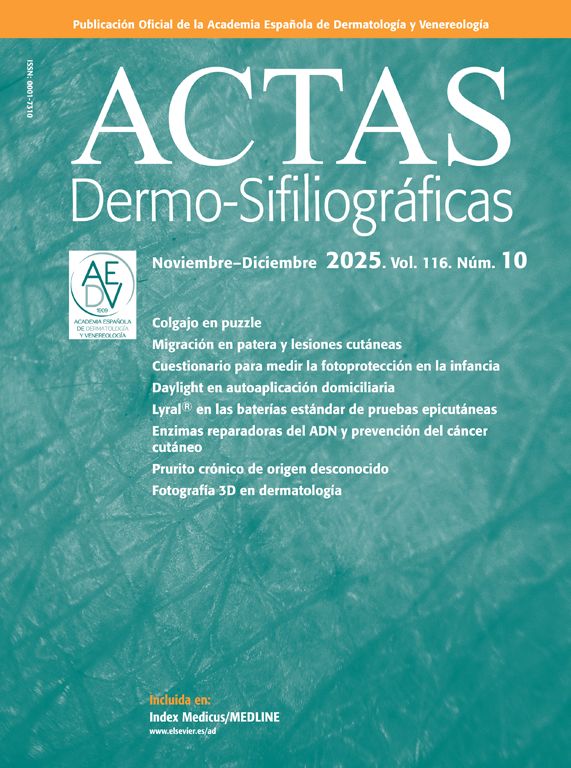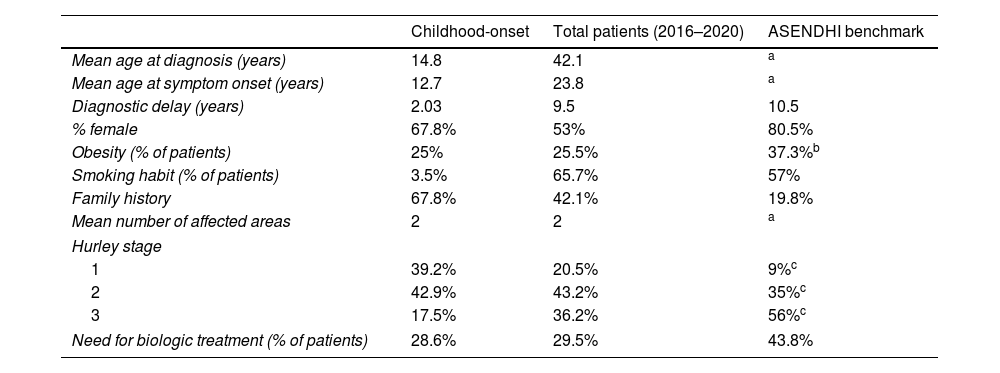Hidradenitis suppurativa (HS) is a chronic inflammatory disease affecting the hair follicle.1 It is one of the dermatological conditions that affects the patients’ quality of life significantly.2
Multiple studies conclude that the mean age of diagnosis is around 20 years,1 but, on the other hand, approximately 35% of patients,3 despite being diagnosed at these ages, report having started with symptoms in childhood or adolescence, which highlights a delay in diagnosis, characteristic of this disease4 associated with worse progression progression, mainly attributed to a longer course of the disease.5
Literature describes the characteristics of patients who started the disease in adolescence, but were mostly diagnosed in adulthood.5,6 In contrast, descriptions of patients when diagnosed during childhood and adolescence are scarce.
In this context, we conducted an observational, retrospective, and single-center study collecting all patients diagnosed with HS at Hospital Universitario Doctor Peset from the start of the dedicated clinic in 2016 to April 2024. Those who at the time of diagnosis were aged between 0 years and 17 years and 11 months were selected.
Demographic characteristics (age at diagnosis, age of disease onset, sex, weight, height, body mass index [BMI], comorbidities, smoking and alcohol habits, and family history of HS) and clinical characteristics at diagnosis were collected, including affected locations, Hurley stage, and the need for biological treatment throughout follow-up.
Comparison with patients diagnosed in adulthood in our setting was drawn with respect to the III Barometer of the Association of Hidradenitis Patients (ASENDHI)7 and the manuscript published by Melgosa et al., which includes patients from our own dedicated clinic diagnosed between 2016 and 2020.8
A total of 532 patients have been diagnosed with HS at our center, of whom 28 (5.3%) were diagnosed in childhood or adolescence.
The mean age at diagnosis was 14.8 years (9–17), the mean age of symptom onset was 12.7 years (7–16), and the mean diagnostic delay, 2 years. In patients diagnosed in our setting, this diagnostic delay is 9.5 years on average at our center and 10.5 years in the ASENDHI barometer.
Only one patient reported smoking, and 3, occasional alcohol consumption: habits very different from the general population diagnosed with HS, in which we find 65.7% of smoking patients at our center and 57% in the ASENDHI barometer.
Up to 67.8% (19) of patients diagnosed in childhood and adolescence reported a family history of HS, unlike the population in our setting, in which a percentage <42.1% was reported at our center and only 19.8% in the ASENDHI barometer.
At diagnosis, 39.2% (11) were in Hurley stage I, 42.9% (12) in Hurley stage II, and 17.8% (5) in Hurley stage 3; data that differ from those observed in the general population, being 20.5%, 43.2%, and 36.3% the patients diagnosed in Hurley stage I, II, and III, respectively, at our center, and in the ASENDHI barometer, 9%, 35%, and 56% the patients classified as mild, moderate, and severe, without reference to the correlation of this severity with the Hurley stages.
Throughout the evolution, a total of 28.6% (8) of patients diagnosed in childhood or adolescence have required biological therapy, a figure similar to that of patients in the general population who have needed biological therapy at our center (29.5%), but very different from that reported by the ASENDHI barometer, in which up to 43.8% of the patients who completed the survey received biological therapy.
The full results are presented in Table 1.
Results in patients diagnosed in childhood vs patients diagnosed in our monographic unit (2016–2020) vs ASENDHI benchmarks.
| Childhood-onset | Total patients (2016–2020) | ASENDHI benchmark | |
|---|---|---|---|
| Mean age at diagnosis (years) | 14.8 | 42.1 | a |
| Mean age at symptom onset (years) | 12.7 | 23.8 | a |
| Diagnostic delay (years) | 2.03 | 9.5 | 10.5 |
| % female | 67.8% | 53% | 80.5% |
| Obesity (% of patients) | 25% | 25.5% | 37.3%b |
| Smoking habit (% of patients) | 3.5% | 65.7% | 57% |
| Family history | 67.8% | 42.1% | 19.8% |
| Mean number of affected areas | 2 | 2 | a |
| Hurley stage | |||
| 1 | 39.2% | 20.5% | 9%c |
| 2 | 42.9% | 43.2% | 35%c |
| 3 | 17.5% | 36.2% | 56%c |
| Need for biologic treatment (% of patients) | 28.6% | 29.5% | 43.8% |
Patients with HS diagnosed during childhood and adolescence show a shorter diagnostic delay, up to 4 times shorter, which is accompanied by a decrease of almost 20% in patients diagnosed in Hurley stage III, such that a higher percentage of patients at diagnosis can be included in the “window of opportunity”9 in which medical treatment is more effective and allows preventing disease progression. In any case, we cannot ignore the fact that, despite this shorter diagnostic delay, up to 17% of cases diagnosed in minors do so in Hurley stage III and a delay of 2 years persists, so it remains a point to improve for the future.
In the pathogenesis of the disease, we also see differences, given that minor patients present little or no association with tobacco consumption, frequent in the adult population and described as a pathogenic factor and risk of disease severity,10 and on the other hand, they present a greater number of family history of HS, which has been related to a greater genetic component in these patients,6 unlike patients with a later age of onset, in whom the accumulation of environmental factors would have a greater impact.
Other characteristics, such as the higher prevalence in the female sex, obesity, and the number of locations and most frequently affected locations are similar to those present in patients diagnosed in adulthood.
In conclusion, patients with HS diagnosed during childhood and adolescence present a shorter diagnostic delay, which allows them to be diagnosed at an earlier stage of the disease, benefiting to a greater extent from the initiation of more aggressive medical therapies.
These patients present little or no influence of tobacco on the pathogenesis of the disease, with genetic factors, linked to a greater presence of family history, possibly being a key factor in its appearance.




